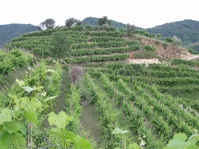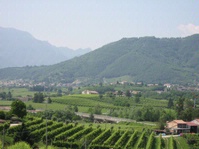|
|
 |
|
June 28, 2018
What are you willing to pay for a good bottle of wine? The answer, I assume, depends on your budget.
The occasional splurge wine aside, the sweet spot for the vast majority is somewhere between $10 and $30. In that price range there are a surprising number of excellent options provided by wineries that aspire to overdeliver.
I've identified five of my personal favorites for this week's "Wine Talk." Most of them are distributed nationally and widely available. All were chosen because they compare favorably to wines that are far more expensive. I think of it as affordable luxury! Here are the fabulous five:
Centine is an entry-level wine that hardly acts the part. Produced by Castello Banfi from indigenous Italian and international grape varieties, the centine rosso is the best Super Tuscan-style wine for the money, bar none. It retails for around $12 and compares favorably with other Tuscan red wines at three to five times the price. The bianco and rose are very good, too, but the rosso is the clear-cut star of the lineup.
Dry Creek Vineyard wines are cheap by bargain standards, but they definitely punch above their weight in the $18 to $40 range. The sauvignon blanc and fume blanc are as good as any made in California, and the cabernet sauvignon is remarkably consistent, drinks well when young and has the structure to improve with age for up to 10 years. Pick up this Sonoma County winery and put it down in the Napa Valley and it could double its prices without anyone blinking an eye.
Louis Martini produces one of California's most coveted cabernet sauvignons from its stunning Monte Rosso Vineyard in the Sonoma Valley, but that one will set you back $100 or more. The basic Martini cabs bearing either the Napa Valley or Sonoma County AVA are superb red wines that stand out in their own right in the $25 to $35 price range. This historic Napa Valley winery has long been a standard-bearer for affordable quality.
Rodney Strong is another Sonoma County winery that always delivers a top-notch product at about half the price the wines could fetch if they were made in the nearby Napa Valley. Rodney Strong's grape sources are primarily the Russian River Valley, the Alexander Valley and the Chalk Hill area, but their basic Sonoma County chardonnay and Sonoma County cabernet sauvignon are always near the head of the class in the $20 range.
Wagner Vineyards isn't seen much outside of New York's Finger Lakes winegrowing region, and that's a shame. Its dry riesling, which costs a mere $15, is a superb example of the high-quality riesling being produced in upstate New York. Wagner's entire lineup is outstanding, but the dry riesling is my favorite because of its exquisite balance, scintillating minerality and remarkable ability to improve with age.
|
|
June 25, 2018
I confess to having shifted in my thinking about residual sweetness in high quality Prosecco Superiore DOCG, and based on tastings in Italy in May, I've become pretty settled in my altered view. After first encountering a fair number of bottles that achieved balanced excellence without much sugar on three previous trips, I started to look down a bit at ones with more of it,  both because I knew it wasn’t strictly necessary and also because sugar can be used to cover minor flaws. both because I knew it wasn’t strictly necessary and also because sugar can be used to cover minor flaws.
However, after tasting hundreds of higher-end Proseccos in recent years at all levels of sweetness, I’ve gradually come to the conclusion that the grape variety actually seems most natural and harmonious when finished with residual sugar levels approaching (or at) the “Extra Dry” bottling designation.
The light floral aromas of Glera (as the grape is now called officially, after “Prosecco” was changed from a varietal name to a geographic indicator) seem more expressive in wines of this type, and the flavors seem fuller and more generous, and even the wines’ texture seems different…“fluffier” even though the flavors seem fuller.
Among the producers I visited on this most recent trip was Adami, and the house's “Dei Casel” offers a great case in point while also offering an illuminating opportunity for experimentation. The Adami wines are well represented by Dalla Terra in the USA, and are widely available across the  country, making it possible to taste this head-to-head (preferably “blind") along with the extremely dry “Col Credas” Brut as well as the notably drier “Bosco di Gica” Brut. country, making it possible to taste this head-to-head (preferably “blind") along with the extremely dry “Col Credas” Brut as well as the notably drier “Bosco di Gica” Brut.
Regarding your conclusion from this tasting experiment, I don’t want to “lead the witness” (as they say in legal circles), but neither do I wish to be coy. Stated simply, I “admire” the Brut wines more because I know they are more difficult to craft in a way that results in harmonious, balanced bubbly. But in purely hedonistic terms, I "enjoy" the “Dei Castel” Extra Dry every bit as much, as it offers at least as much pleasure, if not more.
Although it is often true that drier wines can be enjoyed for a longer duration, and that sweeter ones can become a bit tiring after the first glass, that’s not uniformly the case, nor is it a fixed reality that isn’t subject to other factors.
For example, I’ve found that wines in the Prosecco Superiore Extra Dry category harmonize beautifully with the smoky, spicy, salty flavors of charcuterie. So, if you’re in a mood to experiment, don’t just try the Adami wines side-by-side, but extend your lab work to a sampling of the “Dei Castel” Extra Dry with some spicy salami and a few slices of good Proscuitto di Parma … and see if you can resist a second glass of the wine.
Here are reviews of the three Adami wines I've used as examples here, running from the driest to the sweetest. All three are excellent, if very different from one another. If you've tended to look down on sweeter sparklers, tasting these three with an open mind may have the effect of...changing your mind.
Adami, Valdobbiadene Prosecco Superiore DOCG, Veneto, Italy Rive di Farra di Soligo “Col Credas” Brut 2017 ($22, imported by Dalla Terra): This exceptional wine is very close to as good as Brut Prosecco can be. For starters, it is truly bone dry at just 2 to 4 grams per liter of residual sugar, yet it neither comes off as austere nor finishes with any bitterness, as often happens when Glera is finished with essentially no sugar. Additionally, it shows the light floral aromas appropriate to the grape variety but doesn’t produce the phenomenon that professional tasters call “disagreement,” when a dry finish clashes with aromas that promise more sweetness than the wine delivers. Thanks to fine bubbles, restrained fruit, and acidity that provides a fresh edge without turning sharp, one’s comprehensive sense of this is that the wine is brilliantly balanced and harmonious, which is a very impressive achievement in a wine made in this style. 92
Adami, Valdobbiadene Prosecco Superiore DOCG, Veneto, Italy, “Bosco di Gica” Brut NV ($18): Certainly among the best DOCG Bruts (8 – 10 grams per liter of sugar) sold in the USA that isn’t a “Rive” bottling from a single village, this offers excellent quality at a very reasonable price. It can’t match the substance or breadth on the palate of Adami’s “Col Credas,” but the acid balance is every bit as precise, and the mousse is actually a little finer in texture. This is high-class Prosecco that still offers a lot of fun, both because it is so easy to sip but also because it is so easy to pay for with a clean conscience. 90
Adami, Valdobbiadene Prosecco Superiore DOCG, Veneto, Italy, “Dei Casel” Extra Dry NV ($18): Although Adami's Brut Prosecco Superiore wines are undeniably excellent, this bottling seems a bit more luxurious by comparison...despite being less expensive. The scents of fresh blossoms are very expressive and the flavors are open and generous, with a wonderfully foamy, "fluffy" texture to the finish. My descriptors here could mislead you into thinking that this wine might be a bit like a too-soft mattress or a car with overly cushy suspension, so let me head off that misunderstanding immediately: There's plenty of energetic acidity here, giving the wine excellent definition and "cut" for a relatively sweet sparkler, and the resulting balance between juiciness and fresh edginess is the key to its delicious success. 91
Posted by Michael Franz at 12:02 PM
|
|
 |
|